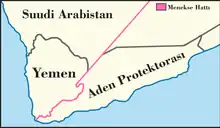
Map showing the Violet Line.
The Violet Line was a boundary line agreed between the United Kingdom and the Ottoman Empire in March 1914.[1][2] It started from the termination of the Blue Line agreed to at the Anglo-Ottoman Convention of 1913 and extended to the border between the Ottoman Yemen Vilayet and the British Aden Protectorates. Together with the Blue Line, the Violet Line effectively divided the Arabian peninsula in two.
References
- ↑ Richard Schofield (31 March 1999), Negotiating the Saudi-Yemeni international boundary, Al-Bab, retrieved 30 March 2020
- ↑ Harry Brown (October 1994), The Iraq-Kuwait boundary dispute: historical background and the UN decisions of 1992 and 1993, IBRU Boundary and Security Bulletin, retrieved 1 April 2020
Further reading
- Anscombe, Frederick F. The Ottoman Gulf: the creation of Kuwait, Saudi Arabia, and Qatar New York: Columbia University Press, 1997.
- Kelly, J. B. Eastern Arabian Frontiers New York: Frederick A Praeger, 1964.
- Kelly, J. B. Sovereignty and Jurisdiction in Eastern Arabia International Affairs (Royal Institute of International Affairs) 34.4 (1958): 16–24.
- Hurewitz, J. C., ed. The Middle East and North Africa in World Politics: A Documentary Record, 2nd edn. Vol. 1: European Expansion, 1535–1914. New Haven: Yale University Press, 1975, pp. 567–570.
- Schofield, Richard. Kuwait and Iraq: Historical and Territorial Disputes. London: Chatham House, 1991.
- Slot, B. J. Mubarak al-Sabah: Founder of Modern Kuwait 1896-1915. Arabian Publishing Ltd, 2005.
- Tallon, James N. "Allies and Adversaries: Anglo-Ottoman Boundary Negotiation in the Middle East, 1906–1914" in Justin Q. Olmsted Britain in the Islamic World Imperial and Post-Imperial Connections London: Palgrave, 2019, 89–105.
- Wilkinson, John C. Arabia’s Frontiers: The Story of Britain’s Boundary Drawing in the Desert, London: I.B. Tauris & Co Ltd, 1991, 100–108.
This article is issued from Wikipedia. The text is licensed under Creative Commons - Attribution - Sharealike. Additional terms may apply for the media files.